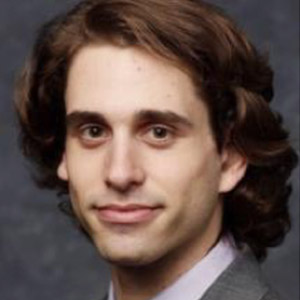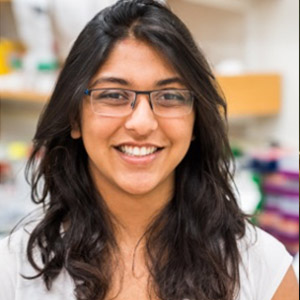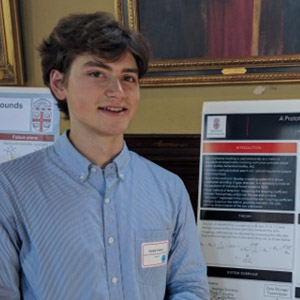Blavatnik Doctoral Fellows: 2018-2019 Cohort
Ethan Bendau, Department of Biomedical Engineering

Ethan Bendau recently graduated with a degree in physics from the City College of New York after earning his first bachelor’s degree in French from the University of Oregon. His research is in biomedical optics and he completed an honors thesis titled, "Early Detection of Triple Negative Breast Cancer using Multiphoton Spectroscopy and Raman Spectroscopy." He is a recipient of the City College Fellowship for promising undergraduates who aspire to earn a PhD as well as the Dr. Jerry A. Gelbwachs Award, a full tuition scholarship for physics and engineering students. As president of the CCNY Physics Club, he organizes community outreach events to promote science and leadership among local middle and high school students. Ethan is enrolled in the biomedical engineering doctoral program.
Update from Ethan Bendau on his first year at Columbia Engineering:
“I am exceptionally grateful to the Blavatnik Family Foundation for this fellowship that allows me to pursue novel questions in the highly interdisciplinary field of biomedical engineering. In the first year of my PhD, I entered a new field and was fortunate to benefit from the wealth of extraordinary scientists at Columbia University and in New York City. At the recent Blavatnik Science Symposium, I met with the award winners and finalists, who taught me a great deal about developing a successful career in science and being part of a broader science community. Thanks to the Blavatnik Family Foundation, I enter my second year more motivated than ever to change the world. As part of the Ultrasound Elasticity and Imaging Laboratory of Dr. Elisa Konofagou, I am exploring the novel application of focused ultrasound (FUS) to non-invasively stimulate or suppress neural activity. In my current research, by tracking heart and breathing rate in anesthetized mice, I monitor the changes in autonomic nervous system function that accompany altered states of arousal during ultrasound application to the brain. This knowledge will aid in understanding of how anesthesia affects neural response to FUS stimulation. It also suggests FUS as a promising avenue for exploring and ameliorating disorders of consciousness such as persistent vegetative state and coma. Next, we will incorporate into this research the techniques of functional ultrasound imaging being developed in our lab. This will allow us to observe the changes in cerebral blood flow that accompany neural activity due to FUS neuromodulation. Throughout my PhD, I hope to elucidate the mechanism of action of this novel brain stimulation technique and develop more robust methods for selective, reversible stimulation and suppression of neural activity.”
John Durel, Department of Biomedical Engineering

John Durel completed his undergraduate studies with the Department of Biomedical Engineering at the University of Virginia. He is interested in research which seeks to characterize diseased and healthy tissue environments for the purpose of designing and deploying novel interventions which harness the inherent behaviors and properties of natural tissue. His previous research has ranged from cancer cell biology to high-throughput microscopy analysis and production of cellular hydrogel constructs. John’s primary nonscientific hobbies include reading, especially historical fiction, and both playing and developing tabletop and electronic games. He is also particularly interested in the general subject of disability-conscious design. John is a doctoral student in the Biomedical Engineering Department.
Update from John Durel on his first year at Columbia Engineering:
“I have begun full-time research in the Morphogenesis and Developmental Biomechanics Lab in Biomedical Engineering under Professor Nandan L. Nerurkar. We use chicken embryos as our model developmental system. My current project revolves around the formation and organization of the small intestine, which forms outside of the embryo’s abdominal cavity in both chickens and humans before being internalized later in development. Errors in this natural internalization process can result in often fatal birth defects. I am specifically studying the formation of the gut’s characteristic loops, which allow the great length of the gut tube to fit within the much smaller abdominal space. These loops are thought to form by a buckling instability due to differential growth between the gut tube and its attached membranous mesentery. So far, I've collected interesting early data on the role of cell-scale forces in mediating organ-scale mechanics and shape at late developmental stages using mechanical testing of chemically treated samples. I have found that broad induction of cell contraction in whole dissected midguts results in substantial tightening of loops and decreased organ area, suggesting a possible mechanism through which the degree of looping may be actively regulated prior to successful gut internalization. I am excited to be presenting this work in poster form at both the Society for Developmental Biology Annual Meeting later this month and at the Biomedical Engineering Society Annual Meeting in October. Moving forward, I will continue to study and characterize the role of cell contractility in intestinal loop formation and work to elucidate the possible underlying cell signaling mechanisms that modulate this local force regulation during development.
To support my research endeavors I have undertaken a relevant and rigorous graduate curriculum.. I have excelled in all of these courses. Moving forward, I intend to take courses in Developmental Biology, Elasticity, and Numerical Methods to further strengthen my core biology, mechanics, and computation knowledge base.”
Erin Louwagie, Department of Mechanical Engineering

Erin Louwagie is studying under the guidance of the Department of Mechanical Engineering. She recently completed her MS in mechanical engineering at the University of Minnesota - Twin Cities. Erin has worked on several research projects, including a device to improve lateral flow assay diagnosis and an assistive robot to help individuals with upper extremity disabilities. In her spare time she enjoys playing the French horn, reading, and traveling.
Update from Erin Louwagie on her first year at Columbia Engineering:
“I had a great first year as a SEAS student. I really enjoyed my classes, and I performed well in them. The classes I took were primarily focused on furthering my knowledge of bioengineering and preparing me for my qualifying exam. I passed the qualifying exam in May.
Being a Blavatnik Fellow allowed me to rotate labs between fall and spring semester in order to figure out lab that aligned more with my interests. I spent fall semester working with Dr. Karen Kasza studying the mechanics of cell crawling in drosophila embryos, and I spent spring semester working with Dr. Kristin Myers studying the mechanics of the uterus and cervix during pregnancy. Ultimately I decided to continue on in the Myers lab, as I really enjoy the breadth of work I am able to do as a member of her lab. The research I am working on involves running mechanical tests on tissue, creating FEA models of the uterus and cervix in pregnancy, and working directly with doctors and patients to study normal and high-risk pregnancies.”
Sitara Persad, Department of Computer Science

Sitara Persad is a doctoral student in the Department of Computer Science. Born in the island nation of Trinidad and Tobago, she was awarded a national scholarship to attend Massachusetts Institute of Technology (MIT), where she graduated with a double major in mathematics and computer science, and conducted research in RNA structure biology. Her research interests lie in the intersection of computational biology and machine learning, particularly in Bayesian Inference. In her spare time, she enjoys dancing and playing badminton.
Update from Sitara Persad on her first year at Columbia Engineering:
“During my first year at Columbia, I was fortunately able to hit the ground running with research. I joined a project in collaboration with researchers at Memorial Sloan Kettering to infer copy number variants using an expression-based model using single cell RNA sequencing data. We have been developing and implementing this probabilistic model in order to characterize and understand the structure of highly heterogeneous tumor samples. We have further been working on methods which allows us to separate subclones with varying copy number profiles in order to develop an understanding of the evolutionary processes that lead to intra-tumor heterogeneity. In the coming months, we hope to further develop our methods as well as compare and benchmark our method against existing tools.”
Caleb Tulloss, Department of Electrical Engineering

Caleb has joined Professor Ken Shepard's Bioelectronic Systems Lab as an electrical engineering PhD student. Broadly speaking, his interests include mixed-signal circuit design, implantable devices, and neuroengineering. During his graduate work, he hopes to work on high-resolution neural interface and implantable system design for closed-loop experimentation. Last spring he graduated from Brown University with a BS in electrical engineering and completed an honors thesis on a prototype for untethered primate eye orientation tracking, under the direction of Professor David Borton. Caleb was awarded the Neal B. Mitchell '58 Systems Thinking Project Award for this work. He has served as a teaching assistant for several circuits courses at Brown, and was the president of the Brown IEEE student chapter. In his free time, Caleb enjoys playing classical piano, exploring museums and the outdoors, and designing custom electronics for his bicycle.
Update from Caleb Tulloss on his first year at Columbia Engineering:
“I spent most of the past year completing the requirements for my MS degree, taking 8 courses related to integrated circuit design. These were challenging and rigorous, but I excelled in all courses, and more importantly, I learned valuable design skills that I am now applying in my research. I also served as a teaching assistant for two courses, and have continued my teaching development during the summer through the Center for Teaching and Learning.
I am now working with another student in our research group to design the electronics for a 1,024-channel neural recording array on a single CMOS integrated circuit. The system will consist of amplification, filtering, multiplexing, and data conversion stages, and will interface with passive probes manufactured by a collaborator. We may also include additional functionality, such as stimulation, impedance measurement, and electrode plating control. There are many researchers working in the neural interface design space, but our key advantage will be our system's ability to interface with arbitrary passive probe geometries, allowing for flexibility in choice of neuroscience application.
The first version of our chip design will be complete by the end of the calendar year, and we will continue developing a second version with additional functionality in the first months of the New Year. After that, I intend to spend some time developing digital processing and control software for the interface system, and ultimately (in my later PhD years) get involved with neuroscience collaborators so that I can start using our technology to ask neuroscience questions of my own. I have a lot to learn, and I am excited for what the next few years have to offer!
I would like to thank Mr. Blavatnik for his support; I am so happy to be here at Columbia and I am grateful for the opportunity his funding has provided me.”
